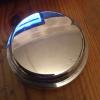Valve Guides
Started by
benspickup2011
, Feb 11 2011 09:03 PM
10 replies to this topic
#1

Posted 11 February 2011 - 09:03 PM
Hello, what are the best sort of valve guides to use in a road engine 1275. When changing them, is it a case of pressing the old ones out and pressing the new ones in? Do they come the correct size or do you need to reem them out? cheers ben
#2

Posted 11 February 2011 - 10:08 PM
This is a job for the pro's... dont even consider trying it yourself.....really dont...
#3

Posted 11 February 2011 - 10:13 PM
There are quite a few topics on this its not really the best job for diy. ideally you will need the valve seat recut to make sire its centered properly some people just lap the valves in and get away with it. There is no such thing as proper size as they are a tolerance fit to the valve so depends on the valves. They need either reaming or honing to correct size if to tight the valve will seize when it gets hot and destroy the engine head and gearbox. The valve should just fall to the seat under its own weight that is a good indication and the best guides to use are standard cast iron unless the valves require a different material.
#4

Posted 11 February 2011 - 11:15 PM
It's really not too difficult so long as you have a large vice.
You knock the old guides out by pressing them in the vice first of all to get them moving, then make up a drift to knock them right through. You can make up a drift by filing the head of a 1/4" bolt down until it is circular, putting it down the guide and hitting the bolt head with a punch and mallet.
Steel guides are the best and to fit them you lightly grease the outside diameter, line each one up in turn, lay the head on its side in the vice and do it up until the guide sits at the correct height above the head upper surface. This height is noted in the workshop manual. If you put no.1 in to the correct height first, then no. 8, you can line the others up using a steel straight edge to save accurately measuring each one.
Once all 8 are installed, run a 9/32" reamer down each guide by hand (i.e.not using a power tool) and check that each valve runs with very slight clearance.
Then take the head to a local machine shop and ask them to 'kiss' the valve seats to ensure that the valves will lap-in nicely.
Lap in the valves and 'jobsagoodun'.
You knock the old guides out by pressing them in the vice first of all to get them moving, then make up a drift to knock them right through. You can make up a drift by filing the head of a 1/4" bolt down until it is circular, putting it down the guide and hitting the bolt head with a punch and mallet.
Steel guides are the best and to fit them you lightly grease the outside diameter, line each one up in turn, lay the head on its side in the vice and do it up until the guide sits at the correct height above the head upper surface. This height is noted in the workshop manual. If you put no.1 in to the correct height first, then no. 8, you can line the others up using a steel straight edge to save accurately measuring each one.
Once all 8 are installed, run a 9/32" reamer down each guide by hand (i.e.not using a power tool) and check that each valve runs with very slight clearance.
Then take the head to a local machine shop and ask them to 'kiss' the valve seats to ensure that the valves will lap-in nicely.
Lap in the valves and 'jobsagoodun'.
#5

Posted 12 February 2011 - 11:31 AM
Never ever use a rwamer..... reamers are by their very nature a very accurate peice of equipment, however to work correctly they need more material in the hole than you would get once they have been pressed in..
Hone or a burnishing tool never a reamer
Hone or a burnishing tool never a reamer
#6

Posted 12 February 2011 - 11:40 AM
Is it really that bad to use a reamer? I alway hear people reaming valve guides, never heard any stories about failure etc due to being reamed instead of honed, and never heard of people recommending honing rather than reaming.
Dont get me wrong I agree that honing is probably more accurate, but if it is such a big NO, then why does everyone do it?!
And why won't a reamer work properly if there isn't a certain amount of material? Surely if it is in good condition it will do its job?
Dont get me wrong I agree that honing is probably more accurate, but if it is such a big NO, then why does everyone do it?!
And why won't a reamer work properly if there isn't a certain amount of material? Surely if it is in good condition it will do its job?
#7

Posted 12 February 2011 - 11:47 AM
What happens is the reamer "dart" about in the hole creating a lot of peaks and vallies, these peaks give the appearance of a reasonably tight valve / guide combination, however after as little as 200 miles these peaks have worn down and the valve become sloppy in the guides oil can easily pass with the resultant issues associated with worn guides.
I get no end of cylinder heads brought to me that have been "reamed" one in particular had done about 200 or so miles, the head of valves could move in a forward or backward direction by up to 1.6mm, side ways by upto 1.0mm
by looking at the surface of the guide that contacts the valve it is easy to see that a reamer has been used.
Now if guides were made with a 0.010" smaller hole then yes a reamer would do a very good job if it was the correct type for the material used, ie Cast iron or Bronze.
Why use a reamer ..... because they are cheap and readily available, honing is normally carried out on dedicated machines....
A reamer needs to have an amount of material to cut and can be anywhere from 0.004" to 0.015" for this size. Normally guides are made to the exact size to fit, once you fit them they can waste down, by as much as 0.002" now a reamer needs more than this to keep it central.
I get no end of cylinder heads brought to me that have been "reamed" one in particular had done about 200 or so miles, the head of valves could move in a forward or backward direction by up to 1.6mm, side ways by upto 1.0mm
by looking at the surface of the guide that contacts the valve it is easy to see that a reamer has been used.
Now if guides were made with a 0.010" smaller hole then yes a reamer would do a very good job if it was the correct type for the material used, ie Cast iron or Bronze.
Why use a reamer ..... because they are cheap and readily available, honing is normally carried out on dedicated machines....
A reamer needs to have an amount of material to cut and can be anywhere from 0.004" to 0.015" for this size. Normally guides are made to the exact size to fit, once you fit them they can waste down, by as much as 0.002" now a reamer needs more than this to keep it central.
Edited by mra-minis.co.uk, 12 February 2011 - 11:51 AM.
#8

Posted 12 February 2011 - 11:49 AM
How about spiral fluted reamers?
#9

Posted 12 February 2011 - 11:53 AM
How about spiral fluted reamers?
In what way do you mean ?
If you are asking, will they cut differently because they are spiral then yes to a certain extent they will, however they still need that amount of material to cut properely.
#10

Posted 12 February 2011 - 12:22 PM
I mean that they can't bounce around because the flutes cover at least 360° of the hole at any time, unlike straight fluted reamers which I understand.
#11

Posted 12 February 2011 - 01:05 PM
What happens is the amount of remaining metal "loads" the flutes if it is not enough then it will skip, bounce, (call it what you will) around. with the correct amount of material the flutes will "load" more equally..
If you have you ever used a chisel, then you will know that if the angle is too shallow it will suddenly jump out off the work piece, now the reamer will do a similar thing however it will then take a "dive" into the other side, much like a shaft that is in a loose bush
If you have you ever used a chisel, then you will know that if the angle is too shallow it will suddenly jump out off the work piece, now the reamer will do a similar thing however it will then take a "dive" into the other side, much like a shaft that is in a loose bush
0 user(s) are reading this topic
0 members, 0 guests, 0 anonymous users

















